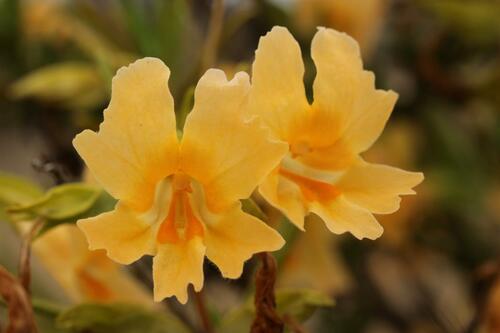Native Trees and Plants You Will See Everywhere in the Bay Area
Introduction
The San Francisco Bay Area is renowned not only for its iconic landmarks like the Golden Gate Bridge and Alcatraz Island but also for its stunning natural beauty. The region is adorned with a diverse array of native trees and plants , enhancing its charm. While exploring popular tourist spots such as Fisherman’s Wharf and Coit Tower, take a moment to appreciate the lush, native landscaping that defines the Bay Area.
Understanding Native Plants
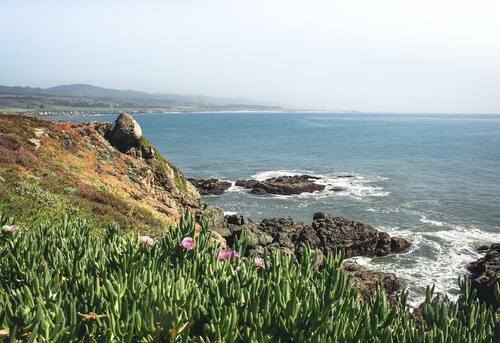
Native Plants on the California Coast – Photo by Jonathan Schmer
What Are Native Plants?
Native plants are species that have naturally evolved and adapted to a specific region over thousands of years. They thrive in the local soil, climate, and geographical conditions without human intervention. Unlike introduced or non-native species, native plants have formed symbiotic relationships with the local wildlife, creating a balanced and sustainable ecosystem.
Importance of Native Plants
Environmental Stability
Native plants play a critical role in maintaining environmental stability. Their deep root systems help to stabilize soil, preventing erosion and reducing runoff. This is especially important in areas prone to heavy rainfall or along coastlines where soil erosion can lead to significant land loss.
Biodiversity and Wildlife Support
Native plants provide essential habitats and food sources for local wildlife. Birds, insects, mammals, and other organisms rely on these plants for shelter and sustenance. For instance, native flowers attract pollinators like bees, butterflies, and hummingbirds, which are vital for the reproduction of many plant species.
Water Conservation
Adapted to the local climate, native plants typically require less water than non-native species. In regions like the Bay Area, where drought conditions can be a concern, planting native species is a sustainable choice. These plants are more efficient at using available water, reducing the need for supplemental irrigation.
Benefits of Growing Native Plants

A Native Flowering Plant Being Cared For – Photo by Cottonbro Studio
Low Maintenance
Once established, native plants are generally low maintenance. They are adapted to local soil and climate conditions, making them more resistant to pests and diseases. This reduces the need for chemical fertilizers and pesticides, promoting a healthier garden environment.
Economic Advantages
Using native plants can be cost-effective in the long run. Since they require less water, fewer fertilizers, and minimal pest control, homeowners can save on gardening expenses. Additionally, native plants can increase property value by enhancing the aesthetic appeal of a landscape with natural beauty.
Climate Resilience
Native plants are more resilient to local climate extremes, such as drought, frost, and storms. Their ability to withstand harsh weather conditions ensures that they continue to provide ecological benefits even in challenging environments.
Supporting Pollinators
Pollinators like bees, butterflies, and birds are crucial for the reproduction of many plants. Native plants have evolved alongside these pollinators, offering the specific nectar, pollen, and habitat these creatures need. By planting natives, gardeners can support healthy pollinator populations, which in turn supports food crops and flowering plants.
Challenges and Considerations
Invasive Species
Invasive non-native plants can outcompete native species, disrupting local ecosystems. They often spread aggressively, crowding out native plants and altering habitats. Gardeners should be mindful of the plants they introduce to avoid inadvertently supporting invasive species.
Restoration and Preservation
Efforts to restore native plant populations can be challenging but are essential for maintaining biodiversity. Conservation groups and local governments often engage in restoration projects to reintroduce native plants to areas where they have declined.
How to Start Growing Native Plants
Research and Planning
Start by researching the native plants of your region. Understanding which species are best suited to your soil type, light conditions, and local climate will help you make informed choices. Local nurseries and extension services can provide valuable guidance.
Soil Preparation
Prepare your soil by removing any invasive species and adding organic matter if needed. Native plants often prefer well-drained soils, so ensure proper drainage to prevent waterlogging.
Plant Selection
Choose a variety of native plants to create a diverse and resilient garden. Consider trees, shrubs, perennials, and groundcovers to provide a range of habitats and food sources for wildlife.
Planting and Maintenance
Plant your native species according to their specific requirements. Mulch to retain moisture and suppress weeds, and water plants regularly until they are established. Once mature, native plants typically require minimal maintenance.
Bay Area Trees

A Grove of Coast Live Oaks – Wikimedia Commons
Iconic Native Trees
The Bay Area is home to a remarkable variety of native trees, each playing a vital role in the region’s ecosystems. These trees provide habitats for wildlife, contribute to the area’s natural beauty, and offer numerous ecological benefits.
California Buckeye ( Aesculus californica )
The California Buckeye is a distinctive tree known for its bright yellow-green palmate leaves and striking white flower spikes that bloom in spring. This tree is drought-tolerant and can often be seen growing along hillsides and valleys. The Buckeye’s seeds, encased in a smooth, leathery shell, are toxic to humans and livestock but are an important food source for certain local wildlife.
Redwood Trees ( Sequoia sempervirens )
Redwood trees are synonymous with the Bay Area and Northern California. These towering giants can live for over 2,000 years and grow to heights exceeding 300 feet. Redwoods thrive in the coastal fog belt, where the moist air provides the perfect environment for their growth. More than one hundred redwood parks along the coast offer the opportunity to experience these magnificent trees firsthand. For those short on time, San Francisco’s Golden Gate Park hosts a beautiful California Redwood grove.
Arroyo Willow ( Salix lasiolepis )
The Arroyo Willow is a fast-growing deciduous tree commonly found along streams and wetlands. Known for its soft, fuzzy buds that appear in early spring, the Arroyo Willow provides crucial habitat and food for a variety of wildlife, including birds and insects. Its dense root system helps stabilize stream banks, preventing erosion and improving water quality.
Coast Live Oak ( Quercus agrifolia )
The Coast Live Oak is an evergreen oak that can reach up to 100 feet in height. This tree is notable for its large, spreading branches that grow in a twisted, gnarly fashion as they age. The Coast Live Oak is a keystone species in its ecosystem, supporting a wide range of wildlife. Acorns from this tree are a vital food source for many birds and mammals. The tree’s deep roots and extensive canopy make it highly resistant to drought, further underscoring its importance in the Bay Area’s varied landscapes.
Ecological Significance of Bay Area Trees

A Wide View of the San Francisco Bay – Photo by Robert So
Bay Area trees are not only iconic but also ecologically significant. They contribute to the health of the environment in numerous ways:
Carbon Sequestration
Trees play a critical role in carbon sequestration, absorbing carbon dioxide from the atmosphere and storing it in their biomass. This process helps mitigate climate change by reducing the overall concentration of greenhouse gases.
Habitat Creation
Native trees provide essential habitats for a diverse array of wildlife. Birds, mammals, insects, and fungi all rely on these trees for food, shelter, and breeding sites. For example, the cavities in old Coast Live Oaks are perfect nesting sites for woodpeckers and owls.
Soil Health
Trees enhance soil health by adding organic matter through leaf litter and fallen branches. This organic matter decomposes, enriching the soil with nutrients that support other plant life. Additionally, tree roots help prevent soil erosion and improve soil structure.
Water Regulation
Trees play a vital role in the hydrological cycle. They help regulate water flow, reduce runoff , and improve groundwater recharge. The root systems of trees like the Arroyo Willow are particularly effective at stabilizing stream banks and preventing erosion, thereby maintaining water quality.
Conservation and Preservation
Preserving the native trees of the Bay Area is crucial for maintaining the region’s ecological balance. Several conservation efforts are underway to protect these trees from threats such as urban development, climate change, and invasive species.
Urban Forestry Programs
Many cities in the Bay Area have implemented urban forestry programs to protect and expand green spaces. These programs focus on planting native trees in urban areas, managing existing tree populations, and educating the public about the benefits of urban forests.
Habitat Restoration Projects
Numerous habitat restoration projects aim to reintroduce native trees to degraded areas. These projects often involve removing invasive species, planting native trees and shrubs, and monitoring the health of restored areas to ensure long-term success.
Community Involvement
Community involvement is key to the success of conservation efforts. Local organizations and volunteer groups frequently organize tree-planting events, educational workshops, and conservation activities to engage residents in preserving their natural heritage.
Bay Area Flowers
Sticky Monkey-Flowers in Bloom – Wikimedia Commons
Native Flowers and Their Habitats
The Bay Area’s diverse landscapes are home to an array of stunning native flowers, each uniquely adapted to thrive in the region’s varied ecosystems. From vibrant blooms in woodlands to delicate petals in coastal scrub, these flowers not only beautify the area but also play vital roles in local ecology.
Sticky Monkey-Flowers ( Diplacus aurantiacus )
Sticky Monkey-Flowers are a common sight in the Bay Area, recognized by their bright yellow-orange fused petals and sticky undersides. These flowers typically grow on shrubby stems in coastal scrub, chaparral, and woodland edges. The sticky texture helps protect them from pests. They bloom from late spring to summer and are an important nectar source for hummingbirds and butterflies.
California Tiger Lilies ( Lilium pardalinum )
California Tiger Lilies are striking flowers found primarily in swampy areas and woodlands. They grow from deciduous bulbs, with tall stems bearing orange, red, or yellow flowers adorned with maroon spots. Blooming in the summer, these lilies add vibrant color to moist, shaded environments. They are highly attractive to pollinators like bees and butterflies, which help in their pollination.
Douglas Iris ( Iris douglasiana )
The Douglas Iris is a native perennial that thrives in coastal grasslands and woodlands. These flowers grow from rhizomes, producing narrow leaves and tall stems with two or three blossoms. The blooms, appearing from January to May, come in various colors including purple, lilac, dark blue, and creamy yellow. Douglas Irises are drought-tolerant and are often used in native landscaping for their beauty and resilience.
Ithuriel’s Spear ( Triteleia laxa )
Ithuriel’s Spear , a member of the lily family, is known for its star-shaped blooms that can be blue, blue-purple, or white. This plant grows from a corm and is found in woodlands, grasslands, open forests, and coastal sage scrub. Blooming in late spring, Ithuriel’s Spear provides a delicate splash of color to these habitats. The flowers attract a variety of pollinators, contributing to the ecological health of the area.
Ecological Roles of Native Flowers
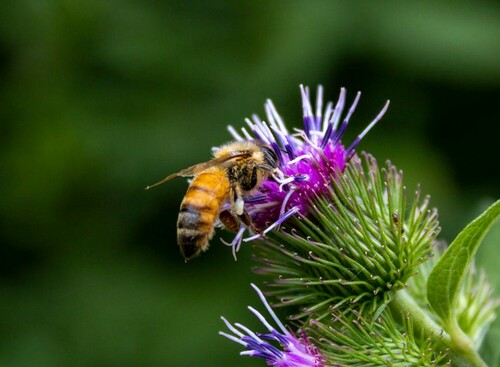
A Bee Gathers Pollen from a Purple Flower – Photo by Gabriel Douglas
Native flowers are essential to the Bay Area’s ecosystems, offering numerous ecological benefits:
Pollinator Support
Native flowers are crucial for supporting local pollinators, including bees, butterflies, and hummingbirds. These pollinators rely on the nectar and pollen provided by native flowers for food. In turn, the pollinators help plants reproduce, ensuring the continuation of these species.
Biodiversity Enhancement
By providing diverse habitats and food sources, native flowers contribute to the region’s biodiversity. They support various insects, birds, and other wildlife, creating a balanced and vibrant ecosystem.
Soil Health Improvement
The roots of native flowers help improve soil structure and fertility. They enhance soil aeration and water infiltration, which benefits other plants in the ecosystem. The organic matter from decomposing flowers also enriches the soil with nutrients.
Water Conservation
Many native flowers are adapted to the Bay Area’s dry summers and can thrive with minimal water. Planting these drought-tolerant species in gardens and landscapes helps conserve water, an important consideration in regions prone to drought.
Popular Spots to See Native Flowers
Gardens of Golden Gate Park
Golden Gate Park is a prime location to see a wide variety of native flowers. The park’s botanical gardens and natural areas showcase numerous native species, providing visitors with an immersive experience of the region’s flora.
Regional Parks and Reserves
Parks and nature reserves throughout the Bay Area, such as Mount Tamalpais State Park and Point Reyes National Seashore, offer excellent opportunities to observe native flowers in their natural habitats. These protected areas are managed to preserve native species and their ecosystems.
Local Trails and Open Spaces
Many local hiking trails and open spaces, such as the Marin Headlands and the East Bay Regional Park District, are home to abundant native wildflowers. Springtime hikes often reveal stunning displays of blooming native flowers.
Gardening with Native Flowers
Incorporating native flowers into your garden can bring a touch of the Bay Area’s natural beauty to your home while providing ecological benefits.
Selecting the Right Species
Choose native flowers that are suited to your garden’s conditions, including soil type, sunlight, and moisture levels. Local nurseries and gardening organizations can provide guidance on selecting the best species for your area.
Planting and Care
Plant native flowers in appropriate locations based on their light and water needs. Grouping plants with similar requirements together can help them thrive. Once established, native flowers typically require less maintenance than non-native species.
Benefits of Native Flower Gardens
Native flower gardens attract pollinators, support local wildlife, and require less water and fewer chemicals. They also enhance the aesthetic appeal of your garden with their unique and varied blooms.
Bay Area Shrubs and Succulents
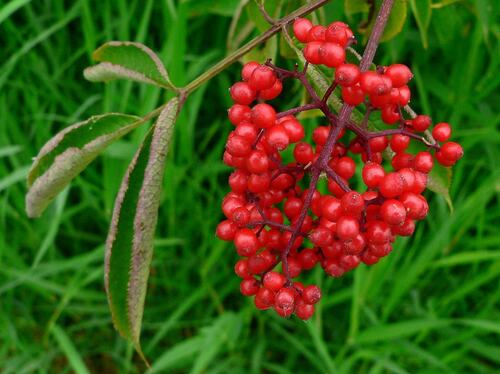
Ripe Red Elderberries – Wikimedia Commons
Hardy Native Shrubs and Succulents
The Bay Area’s unique climate and geography support a variety of native shrubs and succulents that are well-adapted to local conditions. These plants are not only aesthetically pleasing but also ecologically important, offering numerous benefits to the environment and wildlife.
Red Elderberry ( Sambucus racemosa var. racemosa )
Red Elderberry thrives in moist, cool environments such as the banks of riverbeds and creeks. This deciduous shrub can grow up to 20 feet tall and is known for its tiny white flowers, which bloom in dense clusters from May to June. By late summer, these flowers transform into bright red berries. While the berries are toxic when raw due to a cyanide-producing compound, they can be safely consumed once cooked. Red Elderberry provides critical food for birds and other wildlife, and its dense growth offers excellent cover and nesting sites.
California Coffeeberry ( Frangula californica )
The California Coffeeberry is a versatile and hardy evergreen shrub that grows up to 6 feet tall. It is characterized by its thorny , erect stems and clusters of berries that change color from orange to red to black as they ripen in autumn. The Coffeeberry’s foliage provides year-round greenery, and its berries are an important food source for birds and small mammals. This shrub is also used in native landscaping for its drought tolerance and ability to thrive in various soil types.
Coastal Prickly Pear ( Opuntia littoralis )
The Coastal Prickly Pear is a succulent that forms tall, dense clumps of flat, oval, disk-like pads. Each pad is covered in sharp spines and can produce vibrant yellow or red flowers, which bloom in late spring to early summer. Following the flowers, the plant produces edible fruits known as prickly pears or tunas. These fruits are enjoyed by wildlife and humans alike. The Coastal Prickly Pear is well-adapted to sandy and rocky soils, making it an excellent choice for erosion control on slopes and coastal areas.
Live-Forever ( Dudleya spp. )
Live-Forever is a common name for various species of Dudleya , a genus of succulents that can live up to 100 years in the wild. These plants are known for their fleshy, rosette-shaped leaves that can be green or silvery-white. Dudleya species are often found on rocky outcrops and coastal cliffs, where they thrive in well-drained soils. Their long lifespan and low water requirements make them a favorite in drought-tolerant gardens. Dudleya flowers, which appear in late spring and early summer, attract pollinators like bees and butterflies.
California Cholla ( Cylindropuntia californica )
The California Cholla is a cactus species that grows in long, snaky cylinders covered in spiny spikes. It produces yellowish-green flowers with red accents, which bloom in late spring. The Cholla’s dense, thorny structure provides excellent protection and nesting sites for birds. Its flowers attract various pollinators, and the fruits provide food for wildlife. The Cholla is highly drought-tolerant and thrives in sandy, well-drained soils, making it a resilient addition to xeriscapes and native gardens.
Ecological Importance of Native Shrubs and Succulents
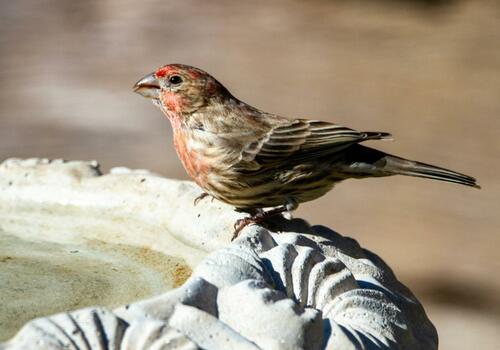
A Native Bird at the Edge of a Bird Bath – Photo by Joshua Cotten on Unsplash
Native shrubs and succulents are vital to the Bay Area’s ecosystems, offering a range of ecological benefits:
Soil Stabilization and Erosion Control
The deep root systems of native shrubs and succulents help stabilize soil, preventing erosion and promoting water infiltration. This is particularly important in the Bay Area’s varied topography, where soil erosion can be a significant concern.
Wildlife Habitat and Food Source
These plants provide essential habitat and food for a variety of wildlife. Birds, insects, and small mammals rely on the foliage, flowers, and fruits of native shrubs and succulents for shelter and nourishment.
Water Conservation
Many native shrubs and succulents are adapted to the Bay Area’s dry summer climate, requiring minimal water once established. Planting these species helps conserve water, reducing the need for irrigation and supporting sustainable landscaping practices.
Landscaping with Native Shrubs and Succulents
Incorporating native shrubs and succulents into your garden can create a beautiful, low-maintenance landscape that supports local wildlife and conserves resources.
Choosing the Right Plants
Select native shrubs and succulents based on your garden’s conditions, such as sunlight, soil type, and moisture levels. Local nurseries and extension services can provide guidance on the best species for your area.
Planting and Care
Prepare the soil by removing any invasive species and ensuring good drainage. Plant your native shrubs and succulents in appropriate locations, and group plants with similar water and light requirements together. Mulching can help retain soil moisture and suppress weeds.
Benefits of Native Landscaping
Native shrubs and succulents require less water and maintenance compared to non-native species. They attract beneficial wildlife, enhance soil health, and reduce the need for chemical inputs. Additionally, their unique forms and textures add visual interest to any garden.
Landscaping with Native Plants
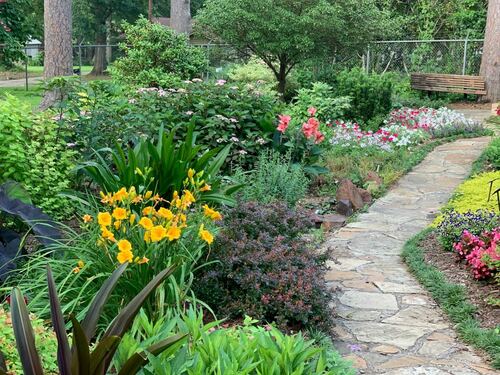
A Garden Featuring Native Plants - Photo by Aniston Grace on Unsplash
Benefits of Using Native Plants in Landscaping
Landscaping with native plants offers a multitude of advantages for both the environment and the gardener. These plants are well-adapted to the local climate and soil conditions, making them a sustainable and low-maintenance choice for any garden.
Environmental Benefits
- Biodiversity Enhancement: Native plants support local wildlife, including birds, insects, and small mammals. By providing food and habitat, they help maintain the ecological balance and promote biodiversity.
- Water Conservation: Native plants are adapted to the local climate, often requiring less water than non-native species. This is particularly important in the Bay Area, where drought conditions are common.
- Soil Health: The deep root systems of many native plants help improve soil structure and fertility. They prevent erosion, enhance soil aeration, and support the soil microbiome.
Economic and Practical Benefits
- Low Maintenance: Once established, native plants generally require less care than non-native species. They are more resistant to local pests and diseases, reducing the need for chemical treatments.
- Cost Savings: Lower water and maintenance requirements translate into cost savings for homeowners. Native plants also reduce the need for fertilizers and pesticides, further lowering gardening expenses.
- Aesthetic Appeal: Native plants offer unique beauty with their diverse forms, colors, and textures. They provide seasonal interest and can be used to create visually stunning landscapes.
Steps to Creating a Native Plant Garden
Planning and Design
The first step in creating a native plant garden is careful planning and design. Consider the following elements to ensure a successful and attractive garden.
Assessing Site Conditions
Evaluate the specific conditions of your garden, including soil type, sunlight, and moisture levels. This will help you select appropriate native plants that will thrive in your environment.
Choosing Native Plants
Select a variety of native plants that suit your garden’s conditions. Incorporate trees, shrubs, perennials, and groundcovers to create a diverse and resilient landscape. Research local native plant nurseries and consult resources such as the California Native Plant Society for recommendations.
Designing for Aesthetics and Functionality
Design your garden with both aesthetics and functionality in mind. Consider plant height, color, texture, and bloom time to create visual interest throughout the year. Group plants with similar water and light needs together to ensure they thrive.
Soil Preparation and Planting
Proper soil preparation and planting techniques are crucial for establishing a healthy native plant garden.
Soil Preparation
Prepare your soil by removing any existing weeds or invasive species. If necessary, amend the soil with organic matter to improve its structure and fertility. Ensure good drainage, especially for plants that prefer well-drained soils.
Planting
Plant native species according to their specific requirements. Dig holes that are appropriate for the root size of each plant and space them according to their mature size. Water the plants thoroughly after planting to help them establish their root systems.
Mulching and Maintenance
Mulching and regular maintenance are important for the long-term health and success of your native plant garden.
Mulching
Apply a layer of mulch around your plants to retain soil moisture, suppress weeds, and regulate soil temperature. Organic mulches, such as wood chips or compost, also add nutrients to the soil as they decompose.
Watering and Pruning
Water your native plants regularly until they are established. Once established, many native plants require minimal supplemental watering. Prune dead or damaged branches to maintain plant health and shape.
Additional Tips for Successful Native Landscaping
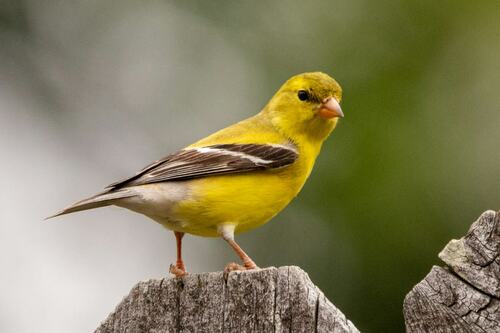
A Yellow Bird on a Backyard Fence - Photo by Joshua J. Cotten on Unsplash
Attracting Wildlife
Incorporate features that attract wildlife, such as bird feeders, bat houses, or water sources like birdbaths. Plant a variety of species that bloom at different times to provide continuous food sources for pollinators.
Avoiding Invasive Species
Be mindful of invasive species that can outcompete native plants and disrupt local ecosystems. Research and avoid planting species that are known to be invasive in your area.
Utilizing Local Resources
Take advantage of local resources and community programs. Many organizations offer workshops, plant sales, and educational materials to help gardeners succeed with native plants.
Inspiring Native Plant Garden Ideas
Pollinator Gardens
Create a pollinator garden by planting a variety of nectar-rich flowers. Choose species that bloom at different times to provide a continuous food source for bees, butterflies, and hummingbirds.
Meadow Gardens
Transform part of your lawn into a native meadow. Use grasses and wildflowers to create a low-maintenance, visually appealing landscape that supports local wildlife.
Rain Gardens
Design a rain garden to manage stormwater runoff. Plant native species that thrive in wet conditions to create a beautiful and functional garden feature.
Woodland Gardens
If you have a shaded area, consider creating a woodland garden with native ferns, wildflowers, and understory shrubs. This type of garden mimics the natural forest floor and provides habitat for shade-loving species.
Conclusion
The native trees and plants of the Bay Area are integral to its natural beauty and ecological health. By appreciating and incorporating these plants into our landscapes, we support local wildlife and contribute to the environment’s sustainability.
Author: Teri Silver is a journalist and outdoor enthusiast. She and her husband live on five acres with a vast lawn, three gardens, a farm, a pond, many trees, and a lot of yard work! The best parts of the year are summer and fall when homegrown veggies are on the dinner table.
Originally posted on September 14, 2023.



